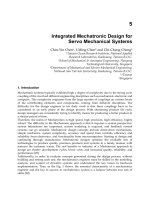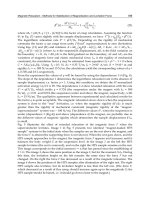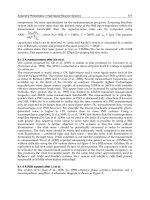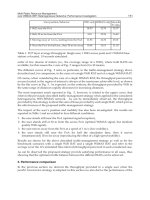Seventy Years of Exploration in Oceanography Part 7 ppsx
Bạn đang xem bản rút gọn của tài liệu. Xem và tải ngay bản đầy đủ của tài liệu tại đây (528.87 KB, 17 trang )
76 11 Institute of Geophysics and Planetary Physics (IGPP) 1962–Present
hockey at Newnham College from 1912–1914, but had to return to Austria when
WWI started. At that time it was most unusual for girls from the Continent to study
in the UK. Her major was in botany, and her tutor was Harold Jeffreys, then a Reader
in Botany.
2
Hasselmann: You have told me that you have three heroes: Sverdrup, Revelle, and
G.I. Taylor. Did you meet Taylor at that time?
Munk: Yes. The three have been my role models: my teacher Sverdrup, my mentor
Revelle, but if you have to use the word “genius,” Taylor is the one. I can imagine
writing some of the papers Harald has written, or fighting some of Roger’s battles,
but G.I , never. Whetherit had todo withwind shear, turbulence, a mushroom
anchor, crystal dislocation, a combination of brilliant insight plus careful laboratory
measurements would yield fundamental truths. In 1986 I p articipated in a celebra-
tion of his hundredth birthday (he was then ten years gone) and said that everything
G.I. had touched turned to gold. Not so, said George Batchelor, who took me to an
attic which stored folders upon folders of work that G.I. had abandoned. Evidently
if an idea did not yield significant results, theoretically or experimentally, within
a month, G.I. would set it aside. Letting things go is not a talent I share.
3
von Storch: I have heard you speak of Sir Edward Bullard as one of the people who
made IGPP what it is.
Munk: Yes, Teddy played a major role. In his later life he spent winters at IGPP
and he died in La Jolla in 1980. By the time I met him, he had truly transformed
the field of geophysics. In the early 1940’s all the major geophysical tools, based
on seismology, gravity, magnetism and geothermal heat flow, had been developed
for use on land, and their application for use at sea was considered to be impossibly
difficult. Bullard played a significant role in the adoption of all four methods for
work at sea; in the cases of heat flow and magnetism he p layed the leading role.
Professor Jerome Namias, a pioneer in climate science, and was waiting outside the door for what
I e xpected to be a short discussion. But of course Namias could not stop talking about his favorite
subject. An hour later Prince Philip came out wiping his brow, “I’m glad we don’t have to worry
about climate in Britain, we already know it’s going to be beastly.”
In 1997 during the last trip of the Royal Yacht Britannia, an of ficial reception was held in Hong
Kong. My brother Alfred, who had a distinguished career as an economist with Standard Oil of
Indiana and rather looked down on his brother’s impoverished academic career, was visiting there
and attended the reception. When his name was announced, Prince Philip asked, “Are you related
to Professor Munk?” Things ha ve never been the same.
2
Mother was with us in 1955 when Sir Harold came for tea. He took one long look at mother and
said “Brunner” (her maiden name).
3
G.I. once took me to dinner at Trinity College, and spoke of some recent work by Michael
Longuet-Higgins on the role of collimation in turning a confused, offshore sea into coherent long-
crested breakers. As wave crests turn parallel to shore by wave refraction in s hallo w water, the
subtended angular beam is narrowed and the waves become more “l ong-crested.” “I don’t think
that’s the whole story,” G. I. said. He had in mind the non-linear capture of short waves by longer,
faster waves coming from behind. The problem is still under consideration.
11.1 The Cambridge Connection 77
Fig. 11.1 Teddy Bullard,
a Cambridge University
Demonstrator, taking grav-
ity measurements in South
Africa (circa 1931)
Today all these methods are routinely used at sea, and in fact their most successful
application has been at sea, not on land. Part of the reason for this reversal is, I think,
because the deep sea is such a benign environment, so well thermostated. But more
important, because the secrets of p late tectonics were hidden under the deep sea and
had to be unraveled by the geophysical measurements at sea. Land geologists could
have banged their hammers on rocks for 10,000 years without having a clue about
the dynamics of continents and ocean basins.
Nearly all the members of the Bullard Laboratory on Madingley Rise have spent
time in La Jolla; and nearly all of us at IGPP have spent some time at the Bullard
Laboratory. Robert Parker, one of our most distinguished faculty members, is
a Bullard product.
Hasselmann: What was your personal interaction with Bullard?
Munk: It was so much fun interacting with him. At one time I had just written the
introduction to a volume dedicated to Bullard when he came u p for another honor,
and I was again asked to summarize his career. I told Teddy I was tired of writing
about him; would he not enjoy saying what he thought was really important in his
career, and I would submit it under my name. He wrote an essay about the things
he remembered, such as coming back from the War and having to wipe the filthy
floor in his Cambridge Laboratory. The manuscript was returned some months later
with most of it crossed out in thick r ed ink. I protested to the Editor who replied,
“We could not possibly publish what you had sent, Sir Edward would be gravely
78 11 Institute of Geophysics and Planetary Physics (IGPP) 1962–Present
offended.” I prevailed, and the essay was published. Teddy got such a kick out of
this that he eventually spilled the beans.
When we were about to move into the IGPP Laboratory,the University architects at-
tached four-digit numbers to each of the offices. But who wants to sit in room 4257?
For identification, we attached photographs of leading geophysicists on the doors.
One of them is of Teddy in the nude (Fig. 11.1), doing magnetic measurements in
Africa. I asked him if he would mind the use of his picture, he said “No, as long
as I do not have to sit behind it.” In reply to your question, Hans, IGPP indeed car-
ries Teddy’s imprint, but not so much because of his very considerable intellectual
achievements, but because he was so much fun.
4
Hasselmann: What about your students?
Munk: They are an indispensable part of IGPP history. Let me mention two students
who became life-long friends. Jim Cairns came to us from the Point Loma Navy
Laboratory and received his degree in Physical Oceanography in 1974. From the
very start he was pre-occupied with electric connectors in an ocean environment.
Existing connections were made in an air environment protected by a leak-proof
housing built to withstand large exterior pressures. Jim asked, “Why not make the
connections in non-conducting fluid at ambient pressure?” and spent his life de-
signing wet-mateable connectors. In 2009 when he sold Ocean Design Inc. (ODI)
to Teledyne, it held virtually a global monopoly in underwater electric connectors.
Judith and I had invested $10,000 in Jim in the early 1980’s when he was dirt-poor.
Last year upon the sale of ODI I retrieved a million dollars. We have stayed in close
contact. I recently had a splendid visit with Jim in a 12th century nunnery near
Urbano, Italy, which Jim and his wife restored for their residence.
Another student, Giuseppe Notarbartolo di Sciara, had been introduced to us by
my Italian cousins. In 1974 when he first came to Scripps to study marine biology,
he stayed with us for a few days while he was looking for lodging. As it turned
out, h e was to stay with us for seven years, until he received his degree in 1980.
The Notarbartolo’s p layed a distinguished role through centuries of Sicilian history.
When Giuseppe arrived he was an advanced diver and held a captain’s license. While
working alone from a small boat off the coast of Baja California collecting data on
manta rays, the “beautiful flying saucers in the Sea of Cortez” as he called them, his
boat caught on fire and sank. Giuseppe barely made it to shore in a dingy, saving
only his passport and a draft of his dissertation (the dingy is featured in the Seiche
garden). He discovered a new species of manta rays (Fig. 11.2), which he named in
4
This gives me the opportunity of recalling something that did not happen (Fig. 11.3). Teddy and
I were driving through the English countryside when we passed a farm with a most remarkable
contraption; a large piece of machinery with a collection of wheels and cylinders on all sides. We
could not think of any possible function. Teddy took a careful photograph. At the time Members
of the National Academy of Sciences could publish in the Academy Proceedings without review.
Our intent was to submit a joint article with the photograph as Fig. 11.3 and legend “see text,” but
no further reference t o the figure.
11.1 The Cambridge Connection 79
Fig. 11.2 Mobula munkiana, a species of manta rays discovered by Giuseppe Notarbartolo di
Sciara in the Gulf of California in 1979
my honor, Mobula munkiana, and best of all asked me to best man at his wedding.
Last year I spent a week at his home on the Greek island of Patmos.
A highlight of my career has been the time spent with my students as advisor on
their Ph .D. committee, as participant in their adventures in research, and ultimately
as their colleague and friend. Starting in 1949: William Van Dorn, Charles (Chip)
Cox, Gordon Groves, Earl Gossard, June Pattullo, Arthur Maxwell, John Knauss,
Gaylord Miller, Brent Gallagher, Mark Wim bush, James Irish, James (Jim) Cairns,
Gordon Williams, Peter Worcester, John Spiesberger, Mike Brown, Donald Altman,
80 11 Institute of Geophysics and Planetary Physics (IGPP) 1962–Present
Fig. 11.3 “Look out below.” See text
Jeffrey Nystuen, Bruce Howe, Brian Dushaw, and Werner Morawitz. I have learned
as much from them as they have learned from me.
11.2 Finding the Faculty
von Storch: Lets get back to IGPP. How did you get started?
Munk: We started as a component of a state-wide IGP centered at UCLA, formed
with the encouragement of Sverdrup and Rossby. There was an immediate problem
as to whom I was to report to, UCLA director Louis Slichter, or Scripps director
Roger Revelle. I remember a tense discussion between the two Directors. My loyalty
clearly went to Scripps, but the problem never quite went away. At one time, Nobel
Chemist Willard Libby who h ad succeeded Slichter as director, came to La Jolla to
order me to report to him, and to take steps towards taking over some of Scripps,
since Oceanography was a subset of geophysics, and not the other way around.
von Storch: What was your intended mission?
Munk: We never came even near to writing a “mission statement.” But it as a matter
of shear luck that forming our geophysical laboratory within an oceanographic insti-
tute pretty well overlapped with the plate-tectonic revolution. That gave us a general
11.2 Finding the Faculty 81
direction. I spent my time on appointments and promotion and on very little else;
very little on what is usually called Administration and certainly not on money mat-
ters.
5
This permitted me to go on with research and teaching for the 23 years I served
as Director of the La Jolla Laboratories of IGPP (1959–1982). I believe that IGPP
faculty and researchers regarded me as a colleague rather than as Director, a crucial
distinction. And so it has been with successive Directors.
Hasselmann: Well, that I can only confirm. I came to IGPP in 1961, just after it
was created, and found the atmosphere extremely stimulating and exciting. In fact, I
found your description of how Cambridge inspired you to create an institute founded
on individual scholarship quite interesting, as I had exactly the opposite impression
when I visited Cambridge after having spent some years at IGPP. I found Cambridge
pleasant, but rather uninspiring in its tradition-bound, rather reserved individual-
ism, in contrast to the excitement of the many seminars, discussions and spaghetti-
and-wine parties in your home in those first years of IGPP. And it was essential, of
course, for the spirit of IGPP that the director was having as much fun as everybody
and was participating in a team effort.
When I became director of the Max Planck Institute of Meteorology in Hamburg in
1975, after experiencing other institutions as Doherty Professor at the Woods Hole
Oceanographic and director of the Geophysics Institute of Hamburg University, it
was always IGPP that I turned to as my role model of how to run an institute.
Fortunately, the Max Planck Society has the same philosophy as yours, the directors
should be relieved of administrative duties (with the support of the central Max
Planck administration in Munich) and should be free to do good research. But how
exactly did you go about making the appointments?
Munk: In a very unstructured way. Let me give you one example. I met Klaus Has-
selmann at the Ocean Wave Conference in Easton in 1961, where Klaus presented
his solution to the nonlinear interactions between wave components. Klaus intro-
duced his talk with the following statement, “Basically, I solved this problem to
relieve my frustrations at not being able to solve the turbulence problem.” The room
was filled with people who had for years tried to solve the wave interaction prob-
lem, and they were not exactly ecstatic with this statement of a twenty-nine year
old. Life was simple in the early sixties, and I was able to offer Klaus an Assistant
Professorship b efore the conference had closed.
Hasselmann: That is not exactly what I had in mind when I asked of how you went
about making appointments.
Munk: Roger allotted us 4.92 FTE’s (Full Time Faculty Equivalents), and by sharing
some of these with appointments on the newly formed upper campus of UCSD we
5
It was extremely fortunate that we came to maturity during the heydays of a basic science oriented
Office of Naval Research. One day I received $50,000 in excess of a proposal to ONR for my
personal research. I called my project officer, who said, “Yes, I know, we t hought you could use
some extra support for starting the new Institute.”
82 11 Institute of Geophysics and Planetary Physics (IGPP) 1962–Present
were well on the way. (I have no idea where the 4.92 number came from.) Among
the early appointments were George Backus who came from MIT, Freeman Gilbert
from Texas Instruments, and John Miles from UCLA (via Australia). All of them
eventually became members of the National Academy of Sciences. Some other ap-
pointments were not so good.
We never made our appointments in a structured way. We had no formal committees
to choose candidates. We were looking for that person with that extra spark. I was
very much under the Cambridge influence: Bullard, Jeffreys, Taylor. And I remem-
bered a story, possibly apocryphal, about C G. Rossby,
6
the leading meteorologist
of his time. Anyway our process of appointment was unstructured, and we were
very , very lucky.
Hasselmann: Well, maybe it was luck, and maybe it was good instincts and judg-
ment. This is, of course, the risk you take when appointments are made without the
encumbrances of committees. We have the same uncomplicated procedures at Max
Planck.
Munk: Years later Judith and I were reading about the resignation of the then Pres-
ident of the University of California. He was asked by a reporter, “What made you
think of resigning at this time?” The reply, “I thought I had better think of it be-
fore others think of it.” We took a long look at each other. Next week I invited all
of IGPP to lunch and announced that Freeman Gilbert would take over. I had ar-
ranged to go to sea that very afternoon, and by the time I returned everything was
going smoothly. Freeman was succeeded by John Orcutt (former Annapolis gradu-
ate), then Bob Parker (Bullard product), Cathy Constable, and today Guy Masters.
If I may brag a little, I count eight of us at IGPP who are (or were) members of the
National Academy o r the Royal Society, or both. Seeing IGPP develop has been the
most rewarding experience of my career.
11.3 Building the Laboratory
Hasselmann: Yesterday we walked up from Scripps Pier on Biological Grade past
Scripps Library to come to a sign:
Munk Laboratory !Revelle Laboratory
6
Rossby returned to his native Sweden to found a famous Meteorological institute. One of his
appointments was P. Welander who had written some of the basic papers on the thermocline for-
mation. As I remember the story, he encountered Welander in the hall, “And how is your father?”
Welander replied, “There must be some misunderstanding, my father died many years ago.” It
turned out that there were two Welander’s, and Rossby had appointed the wrong one. It was also
his best appointment.
11.3 Building the Laboratory 83
and there were the two red-wood buildings, distinct and yet harmonious. You must
have been very pleased to have your association with Roger memorialized in this
fashion.
Munk: Judith and I were very pleased. The association with the Revelle family is
a central theme in our lives. Roger once said he did not care much for having a build-
ing named for him, but in fact he was quite pleased.
von Storch: Was it difficult to raise the money?
Munk: Not really. We had a number of Brownie points to start with. The Univer-
sity earmarked $486,000, half the estimated cost, provided we could raise the other
half. Next we received $243,000 from the Air Force Office of Scientific Research
(AFOSR), provided we could come up with the remaining half. Next $121,500 from
the newly formed National Science Foundation, and then $60,750 from the Fleisch-
mann Foundation of Nevada. You will note the resemblance to a geometric series
1
2
C
1
4
C :::with a sum of 1 but only after an infinite number of terms. A timid suitor
was once asked how he had approached his girlfriend. “Well,” he said, “she let m e
come half way, and then half the remainingway ” “But then you will neverget
there,” said the questioner. “But I got close enough for all practical purposes.” We
got close enough when we were looking for a remaining $15,000. An officer from
the Research Corporation had come all the way to San Diego to decline our proposal
because he couldn’t see how $15,000 could possibly make a difference. We did not
complain and took him to lunch. By the time his train reached Los Angeles he had
changed his mind.
Hasselmann: I am surprised that the Air Force would lend support. I thought your
connections were entirely with the Navy.
Munk: That goes back to the very start of our discussion when we spoke about
oceanographers and seismologists being unfamiliar with power spectra. I hope my
memory serves me right in the following account. The United States was negotiating
a nuclear test ban with the Soviet Union, and there was a need for an appropriate
monitoring system. Edward Teller was afraid of the Russians decoupling the ex-
plosions in underground cavities. America had proposed the “Geneva Network,”
consisting of pen and ink (!) recording seismometers o f appropriate sensitivity. The
original requirement was in terms of millimeter of pen disp lacemen t per kiloton
of explosive energy at some specified range. At one point President Eisenhower
had to withdraw from the agreement he had already signed because (if I remember
the words) “. . . he had been misinformed by his scientists.” I served on a second
committee under AFOSR sponsorship which redefined the requirements in terms
of a signal-to-noise ratio. One Sunday morning the Director of AFOSR, with two
young Colonels on his sides (looking more like college students than senior offi-
cers) came down the steps to our house, “I understand you would like to start a new
Institute ”
7
7
I had met A FOSR Director some years earlier when I was looking for an opportunity to pho-
tograph sun glitter as a means of estimating the probability distribution of sea surface slopes. If
84 11 Institute of Geophysics and Planetary Physics (IGPP) 1962–Present
Fig. 11.4 The IGPP Laboratory (designed by Lloyd Ruocco) on the site of the old Scripps Com-
munity House (1964)
von Storch: And then what happened?
Munk: We chose the site of the old Community House, half way up the cliffs, where
I had spent my first summer back in 1939. Some people thought we were too far
from the rest of Scripps, then clustered near the foot of the pier. (Today we are
nearer the center of Scripps.) There was concern about the stability of the cliff edge.
The University architects hired a soil specialist who quoted Scripps Professor Fran-
cis Shepard in concluding that “consistent with other considerations” the building
should be placed as far to the east as possible. At a crucial meeting I said “it was”; I
had run into Francis on the way to the meeting, and he told me that he had changed
his mind.
Judith chose an architect, Lloyd Ruocco, who had built some fine residences, but
nothing even close to a laboratory. Judith chose him for his taste, and the fact that his
best houses were built when there was not enough money (a situation we were in). At
first Lloyd was very reluctant to sign a contract with the University. At our weekly
planning meetings he would say, “That’s the right way to do it but the University
would never buy it.” We prevailed (Fig. 11.4). IGPP was built according to plan, on
budget, and in time (Fig. 11.5).
the sea were absolutely calm you would sea a single reflection of the solar disk. When roughened
by even a slight wind, you see millions of glitter points, each designating a facet with the slope
required to reflect the Sun into your eyes. At that time the AFOSR Director had a sked, “Are you
still looking for a photographic plane? You can have our B17 for six weeks if you are ready by
August.” I accepted. Next day Chip Cox came by asking for suggestions for a thesis. The required
images were taken over the Alenuihaha Channel between the islands of Hawaii and Maui. Chip,
who as born in Hawaii, was shoeless. I remember him in the transparent bubble of the B17 leaning
forward to select a site and triggering the camera with his naked toes. The thesis became one of the
most cited papers of the Scripps Institution [43]. Later Chip was elected to the National Academy
of Sciences.
11.3 Building the Laboratory 85
Fig. 11.5 Judith and Walter Munk overlooking the Pacific Ocean on the deck of the newly com-
pleted IGPP building at Scripps (1964). In 1993 the building was officially named the “Judith and
Walter Munk Laboratory”
A serious objection had to do with the choice of redwood for the building material;
the University architect worried whether it would be sufficiently permanent (after
almost fifty years it is doing just fine). In the early 1970’s it was fashionable to
equip laboratories with movable walls. Judith found them ugly and expensive, and
preferred to allow for rare changes by knocking out a few two-by-fours. Our lab-
oratories were originally partitioned into 2=3 wet space and 1=3 electronics. The
walls have now been moved to allow for 1=3 wet space and 2=3 electronics and
computing. Among the many objections were the general use of carpets: only the
President’s office was so authorized. We got away by calling it “acoustic floor cover-
ing.” An important innovation was to face the laboratories toward an open courtyard
where equipment could be assembled and tested in portable laboratories, subse-
quently trucked and secured on the afterdeck of our vessels. Accordingly all Scripps
vessels have screw holes on their fantails fou r foot on center. I believe we wer e the
first to employ portable laboratories, but this is now a widespread procedure for
Oceanographic vessels all over the world (Fig. 6.1).
86 11 Institute of Geophysics and Planetary Physics (IGPP) 1962–Present
Fig. 11.6 Ida and Cecil Green with Judith in front of “Spring Stirring,” celebrating the Greens’
gift of Donal Hord’s diorite statue (circa 1964). It has welcomed visitors to IGPP for the past 45
years
von Storch: By now you have been in the building for half a century. What was your
subsequent experience?
Munk: We were originally allowed 16,000 of assignable square feet. When we
started running out of space, we built upstairs mezzanine offices into the high ceil-
ing laboratories (disguised as “storage closets”). Judith put me into one of these; it
shielded me from occasional v isitors to the front office, and it took the wind out of
the sails of people who felt cheated for not being assigned one of the more elegant
upstairs offices.
It is fair to say that people have liked working in the building and the seminar room
overhanging the cliffs is very popular. The Canadian oceanographer Bob Stewart
sent his architects to La Jolla when he was planning the Institute of Oceanography
in Victoria B.C. The English astronomer Fred Hoyle, a frequent visitor, built an
Institute of Astrophysics just north of Churchill College in Cambridge. There is an
obvious resemblance to IGPP to both laboratories.
Cecil Green had just retired as President of Texas Instruments to take residence in La
Jolla. He was an MIT graduate in Electric Engineering. Later he became President of
11.3 Building the Laboratory 87
Fig. 11.7 (a) Cecil Green and Walter in Cabo San Lucas during the 20th Anni versary Celebra-
tion of Project IDA (International Deployment of Accelerometers) (1995) (b) Judith, Walter, John
Orcutt, and Freeman Gilbert on the patio at Hotel Pamilla following the Celebration
Fig. 11.8 Walter with Jon Berger during the opening ceremonies of the Cecil & Ida Green Piñon
Flat Observatory (1980)
Geophysical Services Inc. (GSI), the precursor to Texas Instruments. The 19-story
Green Building for geophysical sciences at MIT was dedicated soon after IGPP
was built. Cecil came by one evening and said he wanted to give our n ew laboratory
a gift. Judith said at once, “Spring Stirring,” her favorite statue by San Diego sculptor
Donal Hord. In the earliest back-of-the-envelope sketches Judith had placed “Spring
Stirring” at the IGPP entrance. Cecil wanted to make an instant decision, so we
drove to Donal’s house and climbed over the fence (he had retired) and viewed it by
flashlight. Cecil loved it, and so “Spring Stirring” has welcomed our visitors ever
since. Donal d ied two years thereafter, and in h is will he had left the statue to Judith
(Fig. 11.6).
Cecil and Ida Green were constant supporters of our activities (Figs. 11.7 and 11.8).
They supported Freeman Gilbert’s global network of digital seismometers (IDA for
88 11 Institute of Geophysics and Planetary Physics (IGPP) 1962–Present
International Deployment of Accelerometers). They helped establish the Pinon Flat
Observatory above Palm Desert where Jon Berger and others installed a 1 km long
laser strain meters. But more important, Cecil felt that we needed more contact with
geophysical activities elsewhere, and endowed the Green Scholarship for visitors to
IGPP. By now 156 Green Scholars have spent time with us; I would say that they
include a majority of workers in our field from all over the world.
Thirty years later we had really run out of space and started planning for the Roger
and Ellen Revelle Laboratory of the Cecil and Ida Green Institute of Geophysics
and Planetary Physics (quite a mouthful). Fortunately there was space on the steep
hillside across the Biological Grade, on the west side of La Jolla Shores. The chal-
lenge was to build the new laboratory in harmony with the old building, but without
aping it. We again opted for redwood. By then the University review process has
become much more formal, and the plans had to approved by an architectural con-
trol committee. The committee was chaired by a San Francisco architect who had
been one of Judith’s teachers at Harvard. He said, “You cannot use redwood; by the
time you start building the price could go sky-high.” Some days later Judith said,
“He is right of course; why don’t we buy the lumber now and let it age for a year.”
Fortunately we had the building funds at our control, and we hired a wood specialist
in Oregon to select the lumber. At the next meeting, the architect said, “I thought I
told you not to use redwood, the price might go sky high” to which Judith replied,
“You are right, so we bought it already.” As it turned out, the price of redwood rose
precipitously. We had bought somewhat more than required, and sold the balance at
aprofit.
Klaus, we spent yesterday afternoon walking through the two buildings. Perhaps
you would like to comment?
Hasselmann: Well, for me it was quite a nostalgic experience wandering through
the beautiful building in which I had worked in the early sixties, just after it had
been built, admiring again the elegant seminar room with its distractive view over
the Pacific, and gazing out on to the same view from the spacious window of my
old o ffice next door. But I must say, the new building on the adjacent hillside is
equally harmonious. Although using the same architectural elements, it has its own
distinctive style, using the topology of the hillside, with its many trees and spaces
for small patios to create a relaxing Japanese atmosphere.
Munk: One challenge for the new building was to provide for a safe connection
with Nierenberg Hall and other Scripps buildings on the east side of La Jolla Shores
Drive. Judith and I had spent three months in Tasmania (Fig. 8.5) where we fallen
in love with a cable-stayed bridge. So we included a cable-stayed footbridge in
the design of the new laboratory. At the time there were no such bridges in Western
North America. By luck, UCSD’s Dean of the Jacobs School of Engineering, Frieder
Seible was an expert on cable-stayed bridges. He said, “Let me build it.” In a recent
international collection of the best 200 bridges, ours was included.
11.3 Building the Laboratory 89
Fig. 11.9 The Revelle Laboratories of IGPP (designed by Fred Liebhardt) with cable-stayed bridge
(designed by Frieder Seible) in background (1993). Judith and Walter fell in love with a cabl e-
stayed bridge in Tasmania and were pleased t o discover that UCSD Professor Frieder Seible was
anxious to design one. The bridge provided a much needed safe pedestrian access to the Scripps
east campus. The bridge has since been included among the world’s best 200 bridges
When the old building was named the “Judith and Walter Munk Laboratory” I chose
to move across the Grade into the “Roger and Ellen Revelle Laboratory.” And there
I am today (Fig. 11.9).
Hasselmann: From our discussion it is clear that you took an extraordinary interest
in the physical design of the IGPP Laboratories. It is unusual but must be very
gratifying for the director of a new institute to become so intimately involved in the
details of the building. But, you were, of course, very fortunate in being married to
a gifted architect. However, let us turn to a new topic. On a number of occasions
you have referred to your relations with the U.S. Navy, and ONR in particular. How
did this come about?
Chapter 12
Navy
Munk: It was Roger again. Cdr. Revelle was one of the founders of the Office of
Naval Research (ONR), and he saw to it that the Project Officers were good scien-
tists. Among them was John Knauss who later became the Administrator of NOAA,
Art Maxwell who went to Woods Hole, and many others.
von Storch: You are speaking of a period long before the establishment of the Na-
tional Science Foundation. Were the relations with the funding agency different from
what they are now?
Munk: Very different. I would describe the relations then as a partnership between
University and ONR oceanographers. ONR project officers were partners in sharing
the excitement of discoveries. Sometimes they would go to sea with us. I recall one
occasion when we had lost some vital gear overboard and I needed some guidance of
how to proceed, so I telephoned my project officer late at night at home. Continuing
financial support depended more on achievements in the past than proposals for the
future. Of course, there were only a few of us, and the development of personal trust
came naturally. I am very fortunate that the formation o f ONR overlapped with my
career.
von Storch: I would be concerned that this kind of cozy relation you describe is
subject to mis-use.
Munk: It is, and there is no easy answer. I personally much prefer to be subject to
the judgment of powerful project officers than to a majority committee vote. With
time, as the ratio of research demand to support supply increased, it required near-
unanimity to have proposals approved by NSF. This meant that daring proposals
with significant chance of failure didn’t make it. That is bad for all concerned, bad
for the investigator, b ad for the funding agency, and bad for oceanography. I feel
very strongly about this. Years later Judith and I gave our Kyoto Prize money to
Scripps for the benefit of “students engaged in daring research with significant prob-
ability of failure,” with the provision that the decision is to be made personally by
the Director (Fig. 12.1). And we added that if the director does not have a stomach
for taking chances, then “so help us God.”
H. von Storch, K. Hasselmann, Seventy Years of Exploration in Oceanography 91
DOI 10.1007/978-3-642-12087-9, © Springer 2010
92 12 Navy
Fig. 12.1 Emperor Akihito and Empress Kojun welcoming Judith and Walter on the occasion of
the Kyoto Prize (1999)
Fig. 12.2 (a) President Ronald Reagan awarding the National Medal of Science to Walter (1984).
(b) Vice-President George H.W. B ush congratulating Wal ter (1984)
von Storch: You are getting off the subject.
Munk: Sorry. I want to add that the ONR model led to a cadre of civilian oceanog-
raphers who were informed about Navy problems, who cared, and who could offer









